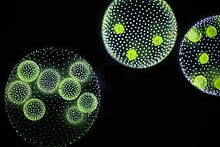
Asexual reproduction is a type of reproduction that does not involve the fusion of gametes or change in the number of chromosomes. The offspring that arise by asexual reproduction from either unicellular or multicellular organisms inherit the full set of genes of their single parent and thus the newly created individual is genetically and physically similar to the parent or an exact clone of the parent. Asexual reproduction is the primary form of reproduction for single-celled organisms such as archaea and bacteria. Many eukaryotic organisms including plants, animals, and fungi can also reproduce asexually. In vertebrates, the most common form of asexual reproduction is parthenogenesis, which is typically used as an alternative to sexual reproduction in times when reproductive opportunities are limited. Komodo dragons and some monitor lizards can reproduce asexually.

The Chlorophyceae are one of the classes of green algae, distinguished mainly on the basis of ultrastructural morphology. They are usually green due to the dominance of pigments chlorophyll a and chlorophyll b. The chloroplast may be discoid, plate-like, reticulate, cup-shaped, spiral- or ribbon-shaped in different species. Most of the members have one or more storage bodies called pyrenoids located in the chloroplast. Pyrenoids contain protein besides starch. Some green algae may store food in the form of oil droplets. They usually have a cell wall made up of an inner layer of cellulose and outer layer of pectose.
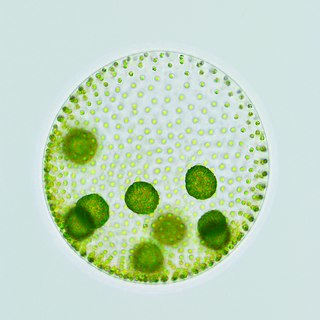
The Volvocaceae are a family of unicellular or colonial biflagellates, including the typical genus Volvox. The family was named by Ehrenberg in 1834, and is known in older classifications as the Volvocidae. All species are colonial and inhabit freshwater environments.

Chlamydomonadales, also known as Volvocales, are an order of flagellated or pseudociliated green algae, specifically of the Chlorophyceae. Chlamydomonadales can form planar or spherical colonies. These vary from Gonium up to Volvox. Each cell has two flagella, and is similar in appearance to Chlamydomonas, with the flagella throughout the colony moving in coordination.
In cellular biology, a somatic cell, or vegetal cell, is any biological cell forming the body of a multicellular organism other than a gamete, germ cell, gametocyte or undifferentiated stem cell. Somatic cells compose the body of an organism and divide through the process of binary fission and mitotic division.
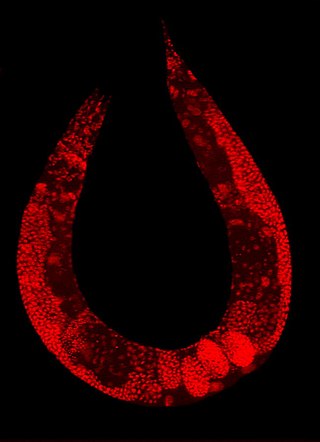
A multicellular organism is an organism that consists of more than one cell, in contrast to unicellular organism. All species of animals, land plants and most fungi are multicellular, as are many algae, whereas a few organisms are partially uni- and partially multicellular, like slime molds and social amoebae such as the genus Dictyostelium.

In biology, a biological life cycle is a series of stages of the life of an organism, that begins as a zygote, often in an egg, and concludes as an adult that reproduces, producing an offspring in the form of a new zygote which then itself goes through the same series of stages, the process repeating in a cyclic fashion.

The green algae are a group consisting of the Prasinodermophyta and its unnamed sister which contains the Chlorophyta and Charophyta/Streptophyta. The land plants (Embryophytes) have emerged deep in the Charophyte alga as sister of the Zygnematophyceae. Since the realization that the Embryophytes emerged within the green algae, some authors are starting to include them. The completed clade that includes both green algae and embryophytes is monophyletic and is referred to as the clade Viridiplantae and as the kingdom Plantae. The green algae include unicellular and colonial flagellates, most with two flagella per cell, as well as various colonial, coccoid and filamentous forms, and macroscopic, multicellular seaweeds. There are about 22,000 species of green algae. Many species live most of their lives as single cells, while other species form coenobia (colonies), long filaments, or highly differentiated macroscopic seaweeds.
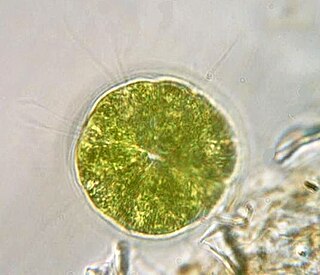
Pandorina is a genus of green algae composed of 8, 16, or sometimes 32 cells, held together at their bases to form a sack globular colony surrounded by mucilage. The cells are ovoid or slightly narrowed at one end to appear keystone- or pear-shaped. Each cell has two flagella with two contractile vacuoles at their base, an eyespot, and a large cup-shaped chloroplast with at least one pyrenoid.
Sex pheromones are pheromones released by an organism to attract an individual of the same species, encourage them to mate with them, or perform some other function closely related with sexual reproduction. Sex pheromones specifically focus on indicating females for breeding, attracting the opposite sex, and conveying information on species, age, sex and genotype. Non-volatile pheromones, or cuticular contact pheromones, are more closely related to social insects as they are usually detected by direct contact with chemoreceptors on the antennae or feet of insects.

Gonium is a genus of colonial algae, a member of the order Chlamydomonadales. Typical colonies have 4 to 16 cells, all the same size, arranged in a flat plate, with no anterior-posterior differentiation. In a colony of 16 cells, four are in the center, and the other 12 are on the four sides, three each. A description by G.M. Smith :
Gonium Mueller 1773: Colonies of 4-8-16 cells arranged in a flat quadrangular plate and embedded in a common gelatinous matrix or connected by broad gelatinous strands. Cells ovoid to pyriform, with a single cup-shaped chloroplast containing one pyrenoid. Each cell with two cilia of equal length, contractile vacuoles at the base of the cilia, and an eyespot. Four- and eight-celled colonies with the cilia on the same side ; sixteen-celled colonies with the four central cells having their cilia on the same side and the twelve marginal cells with radially arranged cilia.
Asexual reproduction by simultaneous division of all cells in the colony to form autocolonies, or by a formation of 2-4 zoospores in each cell.
Sexual reproduction isogamous, by a fusion of biciliatezoogametes.
Astrephomene is a genus of green algae in the family Goniaceae, order Chlamydomonadales. The genus was first described in 1937 by Pocock and named by Pockock in 1953.

Eudorina is a paraphyletic genus in the volvocine green algae clade. Eudorina colonies consist of 16, 32 or 64 individual cells grouped together. Each individual cell contains flagella which allow the colony to move as a whole when the individual cells beat their flagella together. Description by GM Smith :
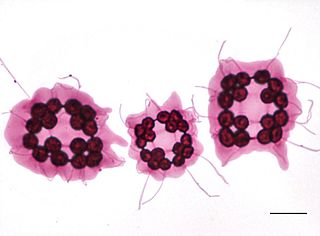
Platydorina is a genus of microscopic green algae in the family Volvocaceae. It contains only one species, Platydorina caudata. It was described by Charles Atwood Kofoid in 1899.

Stephanosphaera is a genus of green algae in the family Haematococcaceae, containing the single species Stephanosphaera pluvialis. It forms colonies of flagellated cells. Although it was once placed in the family Volvocaceae, it is not closely related to them; its sister is the unicellular genus Balticola.

Sexual reproduction is a type of reproduction that involves a complex life cycle in which a gamete with a single set of chromosomes combines with another gamete to produce a zygote that develops into an organism composed of cells with two sets of chromosomes (diploid). This is typical in animals, though the number of chromosome sets and how that number changes in sexual reproduction varies, especially among plants, fungi, and other eukaryotes.
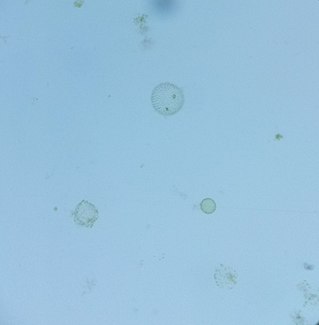
Volvox globator is a species of green algae of the genus Volvox. It was originally described by Carl Linnaeus in his 1758 work Systema Naturae. In 1856 its sexuality was described by Ferdinand Cohn and is the same as Sphaeropleaannulina. It is colonial flagellate found in freshwaters. The colony consists of thousands of zooids arranged in a single peripheral layer. each zooids shows two flagella, two or more contractile vacuoles, cup like chloroplast, a single nucleus, a red stigma but no gullet. Nutrition is holophytic. Size of colony increases by binary fission. In the colony the zooids called parthenogonidia repeatedly divide to form daughter colonies which are released from parent colony.

Volvox carteri is a species of colonial green algae in the order Volvocales. The V. carteri life cycle includes a sexual phase and an asexual phase. V. carteri forms small spherical colonies, or coenobia, of 2000–6000 Chlamydomonas-type somatic cells and 12–16 large, potentially immortal reproductive cells called gonidia. While vegetative, male and female colonies are indistinguishable; however, in the sexual phase, females produce 35-45 eggs and males produce up to 50 sperm packets with 64 or 128 sperm each.
The origin and function of meiosis are currently not well understood scientifically, and would provide fundamental insight into the evolution of sexual reproduction in eukaryotes. There is no current consensus among biologists on the questions of how sex in eukaryotes arose in evolution, what basic function sexual reproduction serves, and why it is maintained, given the basic two-fold cost of sex. It is clear that it evolved over 1.2 billion years ago, and that almost all species which are descendants of the original sexually reproducing species are still sexual reproducers, including plants, fungi, and animals.
Germ-Soma Differentiation is the process by which organisms develop distinct germline and somatic cells. The development of cell differentiation has been one of the critical aspects of the evolution of multicellularity and sexual reproduction in organisms. Multicellularity has evolved upwards of 25 times, and due to this there is great possibility that multiple factors have shaped the differentiation of cells. There are three general types of cells: germ cells, somatic cells, and stem cells. Germ cells lead to the production of gametes, while somatic cells perform all other functions within the body. Within the broad category of somatic cells, there is further specialization as cells become specified to certain tissues and functions. In addition, stem cell are undifferentiated cells which can develop into a specialized cell and are the earliest type of cell in a cell lineage. Due to the differentiation in function, somatic cells are found ony in multicellular organisms, as in unicellular ones the purposes of somatic and germ cells are consolidated in one cell.
